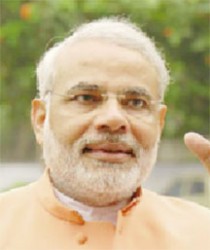BEIJING, (Reuters) – When Indian Prime Minister Narendra Modi arrives in the ancient city of Xian tomorrow at the start of a visit to China, he will be met by Chinese President Xi Jinping, in an unusual departure from normal protocol.

Top Chinese leaders almost never travel outside Beijing to meet senior foreign guests on bilateral visits, and Xi’s appearance in Xian, located in Xi’s home province of Shaanxi, underscores China’s determination to set aside past rancour between the world’s two most populous nations, experts said.
“It definitely indicates the significance our president puts on Mr. Modi’s visit,” said Li Li, an India expert at the government-backed China Institutes of Contemporary Interna-tional Relations.
“From the Chinese side, we were very impressed by the hospitality extended by Mr. Modi during Xi Jinping’s visit to India,” he added, referring to Modi greeting Xi in his home state of Gujarat when Xi visited India last year.
Modi will visit a Xian pagoda connected to Xuanzang, also known as Tripitaka, the monk who bought the Buddhist sutras to China from India thousands of years ago, according to people briefed on the trip.
“It is sending a very important message,” Li said of Xi’s going to Xian to greet Modi, a place closely connected to the deep historical links between China and India.
Still, the list of problems both countries face are considerable, ranging from a festering border dispute to China’s support for India’s arch-rival Pakistan.
Mistrust runs deep, something Xi will be keenly aware of despite the bonhomie and billions of dollars in deals likely to be signed.
New Delhi had raised the issue of a proposed China-Pakistan economic corridor with Beijing, Indian Foreign Secretary Subrahmanyam Jaishankar told a press conference on Tuesday.
The corridor would pass through Kashmir, a region disputed by Pakistan and India.
Xi announced the trade and transit route from Pakistan’s southern Gwadar port on the Arabian Sea to China’s western Xinjiang as part of a $46 billion investment programme during his visit to long-time ally Pakistan last month.
MODI ON WEIBO
Modi’s new account on Chinese social media site Weibo, China’s version of Twitter, was filled with messages soon after launching this month asking him to return what China calls South Tibet, otherwise known as the Indian state of Arunachal Pradesh.
“This is the great, great pressure the Chinese government is facing,” said Mao Siwei, a former senior Chinese diplomat who was based in India and Pakistan, talking about the need to manage Chinese public concern about the disputed area.
China claims more than 90,000 sq km (35,000 sq miles) disputed by New Delhi in the eastern sector of the Himalayas.




